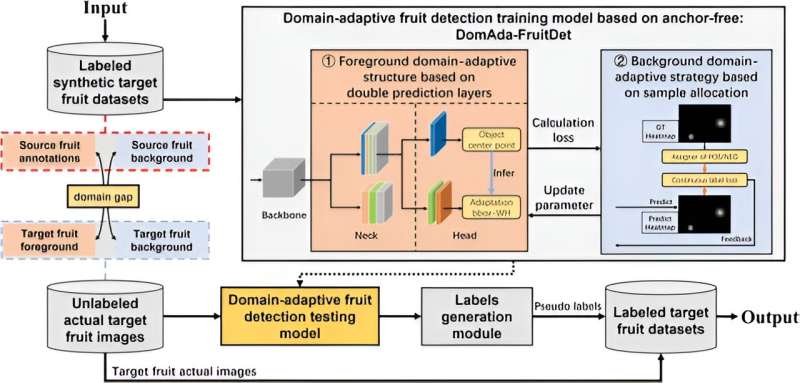This article has been reviewed according to Science X's editorial process and policies. Editors have highlighted the following attributes while ensuring the content's credibility:
fact-checked
proofread
DomAda-FruitDet: Domain-adaptive anchor-free fruit detection model for auto labeling

In the evolving landscape of the modern fruit industry, deep learning-based fruit detection applications have become integral, facilitating tasks such as fruit yield prediction and automated picking. Despite advancements, the labor-intensive process of training data labeling remains a bottleneck.
Previous research introduced the EasyDAM method and leveraged generative adversarial networks to bridge the gap between labeled source domain datasets and unlabeled target domain images, achieving notable success in auto-labeling.
However, challenges persist due to a significant "domain gap" between the synthetic training data and the real-world application data, particularly regarding foreground object scale and background inconsistencies.
In January 2024, Plant Phenomics published a research article titled "DomAda-FruitDet: Domain-Adaptive Anchor-Free Fruit Detection Model for Auto Labeling." The study aims to refine the detection model design to mitigate domain gaps, enhancing the generalization capability of deep learning models for more accurate and efficient fruit detection in smart orchards.
Researchers developed DomAda-FruitDet, a domain-adaptive anchor-free fruit detection model integrating a double prediction layer-based foreground domain-adaptive structure for generating adaptive bounding boxes, effectively bridging the foreground domain gap, and it employs a background domain-adaptive strategy via sample allocation to mitigate the background domain gap.
Tested across various fruit datasets, including apple, tomato, pitaya, and mango, DomAda-FruitDet achieved impressive average precision scores of 90.9%, 90.8%, 88.3%, and 94.0%, respectively, signifying a substantial improvement in auto-labeling precision.
The efficacy of this model was further validated through extensive experiments utilizing datasets from EasyDAMv1 and EasyDAMv2 which encompass both synthetic and actual fruit images. The results demonstrate its capability to adaptively generate high-quality labels even when facing significant domain discrepancies.
The innovative approach of DomAda-FruitDet not only substantially reduces the labor and time required for data labeling in the fruit industry but also paves the way for more accurate and efficient deployment of smart orchard technologies.
Through overcoming the intricate challenges of domain gaps, the model showcases promise for enhancing the generalization and applicability of deep learning models in agriculture and beyond, indicating a leap towards more intelligent and autonomous agricultural practices.
More information: Wenli Zhang et al, DomAda-FruitDet: Domain-Adaptive Anchor-Free Fruit Detection Model for Auto Labeling, Plant Phenomics (2023). DOI: 10.34133/plantphenomics.0135
Provided by TranSpread





















